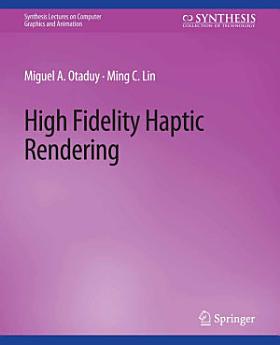High Fidelity Haptic Rendering
Miguel A. Otaduy · Ming C. Lin
2022년 5월 · Springer Nature
eBook
103
페이지
report검증되지 않은 평점과 리뷰입니다. 자세히 알아보기
eBook 정보
The human haptic system, among all senses, provides unique and bidirectional communication between humans and their physical environment. Yet, to date, most human-computer interactive systems have focused primarily on the graphical rendering of visual information and, to a lesser extent, on the display of auditory information. Extending the frontier of visual computing, haptic interfaces, or force feedback devices, have the potential to increase the quality of human-computer interaction by accommodating the sense of touch. They provide an attractive augmentation to visual display and enhance the level of understanding of complex data sets. They have been effectively used for a number of applications including molecular docking, manipulation of nano-materials, surgical training, virtual prototyping, and digital sculpting. Compared with visual and auditory display, haptic rendering has extremely demanding computational requirements. In order to maintain a stable system while displaying smooth and realistic forces and torques, high haptic update rates in the range of 500-1000 Hz or more are typically used. Haptics present many new challenges to researchers and developers in computer graphics and interactive techniques. Some of the critical issues include the development of novel data structures to encode shape and material properties, as well as new techniques for geometry processing, data analysis, physical modeling, and haptic visualization. This synthesis examines some of the latest developments on haptic rendering, while looking forward to exciting future research in this area. It presents novel haptic rendering algorithms that take advantage of the human haptic sensory modality. Specifically it discusses different rendering techniques for various geometric representations (e.g. point-based, polygonal, multiresolution, distance fields, etc), as well as textured surfaces. It also shows how psychophysics of touch can provide the foundational design guidelines for developing perceptually driven force models and concludes with possible applications and issues to consider in future algorithmic design, validating rendering techniques, and evaluating haptic interfaces.
저자 정보
Miguel A. Otaduy is a post-doctoral research associate at the Computer Graphics Lab at ETH Zurich. He received a Ph.D. in Computer Science from the University of North Carolina at Chapel Hill in 2004, as the result of his work in haptic rendering of geometrically complex objects. He has published in the areas of haptic rendering, collision detection, and physically[1]based simulation of rigid and deformable objects. He has also served in the program committee of several international conferences, and has taught and organized tutorials on haptic rendering at the ACM SIGGRAPH and Eurographics conferences. He is currently a sub-project leader for the soft-tissue modeling cluster of the Swiss National Center of Competence in Research Co-Me (computational medicine). Ming C. Lin is a Professor of Computer Science in the University of North Carolina at Chapel Hill. She received her Ph.D. in Electrical Engineering and Computer Science from University of California at Berkeley. She is recognized worldwide for her research on haptic rendering and real-time physically-based interaction techniques for virtual reality and interactive 3D graphics. She has served as a program and conference chair of many international conferences, as an associate editor and guest editor of several journals in these areas, and as a steering committee member of ACM SIGGRAPH and Eurographics Symposium on Computer Animation and World Haptics Conference. She also co-edited the book, “Applied Computational Geometry”.
이 eBook 평가
의견을 알려주세요.
읽기 정보
스마트폰 및 태블릿
노트북 및 컴퓨터
컴퓨터의 웹브라우저를 사용하여 Google Play에서 구매한 오디오북을 들을 수 있습니다.
eReader 및 기타 기기
Kobo eReader 등의 eBook 리더기에서 읽으려면 파일을 다운로드하여 기기로 전송해야 합니다. 지원되는 eBook 리더기로 파일을 전송하려면 고객센터에서 자세한 안내를 따르세요.





